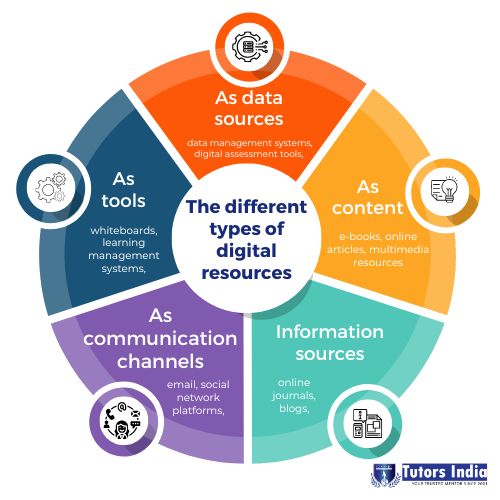Different definitions of digital resources & models/ theories in Education research identified in 2023
Introduction
The digital era has influenced education and students of the present generation with technology and instructional methods for digital learning. Therefore, the responsibility to instil skills for building digital competence in students lies on the teachers. The paper “Digital resources as an aspect of teacher professional digital competence: One term, different definitions – a systematic review”, published in Education and Information Technologies, 2022, identifies several different definitions of digital resources as an aspect of a teacher‘s professional digital competence. These definitions are as follows:

Figure 1:- The different types of digital resources
- Digital resources as tools: This definition views digital resources as tools teachers can use to support teaching and learning. Examples of digital resources in this context include interactive whiteboards, learning management systems, and educational software.
- Digital resources as content: This definition views digital resources as digital content teachers can use to support teaching and learning. Examples of digital resources in this context include e-learning aids like e-books, online articles, and multimedia resources such as videos and images.
- Digital resources as communication channels: This definition views digital resources as communication channels teachers can use to interact with students, parents, and other stakeholders. Examples of digital resources in this context include email, social network platforms, and online discussion forums.
- Digital resources as sources of information: This definition views digital resources as information sources teachers can use to stay up-to-date with the latest developments in their field. Examples of digital resources in this context include online journals, blogs, and professional networks.
- Digital resources as data sources: This definition views digital resources as data sources teachers can use to inform their practice. Examples of digital resources in this context include student data management systems, digital assessment tools, and learning analytics platforms.
What are the different models and frameworks identified in the following paper “Digital resources as an aspect of teacher professional digital competence: One term, different definitions – a systematic review” published in Education and Information Technologies, 2022
The paper “Digital resources as an aspect of teacher professional digital competence: One term, different definitions – a systematic review”, published in Education and Information Technologies, 2022, identifies several different models and frameworks that can be used to understand and develop teachers’ professional digital competence regarding digital resources. These models and frameworks are as follows:
- The Technological Pedagogical Content Knowledge (TPACK) framework: This framework emphasises the importance of teachers’ knowledge of the interactions between technology, pedagogy, and content. It suggests that effective use of digital resources requires teachers to deeply understand how Engineering & technology can enhance teaching and learning in specific subject areas. The Digital
- Competence Framework for Educators (DigCompEdu): This framework provides a set of competencies teachers should possess to use digital resources effectively in their teaching practice. These competencies include skills such as creating and sharing digital content, collaborating with others online, and using digital tools for assessment.
- The Community of Inquiry (CoI) framework: This framework emphasises the importance of social presence, cognitive presence, and teaching presence in online learning environments. It suggests that effective use of digital resources requires teachers to be skilled at creating a supportive online community, facilitating meaningful discussions, and providing clear guidance and feedback.
- The SAMR model: This model provides a framework for understanding the different levels of technology integration in teaching and learning. It suggests that effective use of digital resources involves moving beyond simply using technology to replace traditional teaching methods (substitution) and towards more transformative uses that enable new learning experiences (modification, redefinition).
- The 5Es model: This model provides a framework for designing and delivering engaging and practical science lessons. It suggests that using digital resources effectively enhances the five stages of the learning cycle: engage, explore, explain, elaborate, and evaluate.
Conclusion
To conclude, the paper highlights the importance of digital resources as an aspect of a teacher’s professional digital competence. It suggests that a comprehensive understanding of digital resources is necessary for effective teaching in the digital age. Moreover, it emphasises the importance of using models and frameworks to guide the development of teachers’ professional digital competence concerning digital resources. These models and frameworks can help teachers effectively use digital resources to enhance teaching and learning in their classrooms by offering a systematic approach to understanding and improving digital competence.
Tutors India offers Master’s dissertation services for students specialising in digital technology, which involves creating digital resources valuable for education. It assists the students at research proposal, enhancing the purpose of their research and ensures a high-quality, plagiarism-free dissertation.

 Previous Post
Previous Post